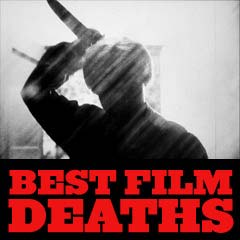
|
Deaths Scenes 1972 |
| Film Title/Year and Description | ||||||||||||||||||||||||

|
Frenzy (1972) In the opening of Hitchcock's thriller, his only R-rated film (and the only film that showed nudity), ex-Mrs. Brenda Margaret Blaney (Barbara Leigh-Hunt) was confronted by charming ladies man Mr. Bob Rusk (Barry Foster): "You're the one I wanted to see....I like you. You're my type of woman." She suffered a long and intense necktie rape-strangulation death scene (a montage composed of a flurry of brief shots). When she begged for her life, he tore off her dress and bra (exposing one breast), screamed at her: "Love me!...Women - they're all the same", and then revealed that he was the notorious Necktie Killer. After a lengthy struggle, she was left dead with her twisted tongue hanging out.
The second strangulation murder (off-screen) was of barmaid Barbara Jane ('Babs') Milligan (Anna Massey) as the camera, in a very length tracking shot, came backwards down the stairs and out across the busy street. It was completely predictable that she was being assaulted in the killer's upstairs apartment (it was unnecessary for Hitchcock to graphically show a second murder-strangulation, so he left it to the viewer's "fill-in-the-blanks" imagination). The final scene was in Rusk's apartment bedroom where framed murderer Richard "Dick" Blaney (Jon Finch) had fled after escaping from prison to kill Rusk. He beat a figure under bedclothes (thinking it was Rusk) with a crowbar, until he realized that the body belonged to an anonymous nude female (Susan Travers) (another strangulation victim murdered earlier off-screen, with contorted features: rolled-back eyes and a curved tongue) when her arm with bracelets dangled off the side of the bed.
[Note: It was highly likely that the same actress, Susan Travers, also appeared in the film's opening, floating face-down in the Thames River as the first seen "Necktie" victim.] Chief Inspector Oxford (Alec McCowen) found Blaney at the scene - now fully implicated, but then heard someone lugging a large trunk up the stairs. They remained quiet as necktie murderer Bob Rusk was tricked into being apprehended after entering (with the damning evidence in his own bed). Oxford noted to Rusk: "Mr. Rusk, you're not wearing your tie." |
 Backwards Tracking Shot After Babs' Murder 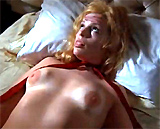 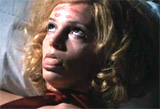  Mr. Rusk's Last Victim 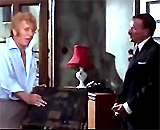 Capture of Necktie Killer |
||||||||||||||||||||||
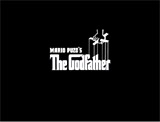
|
In a grisly but riveting murder scene, loyal Corleone henchman Luca Brasi (Lenny Montana) (wearing a bullet-proof vest) met at Tattaglia's bar with the Mafia head's son Bruno Tattaglia (Tony Giorgio) and rival racketeer Virgil Sollozzo (Al Lettieri) (who had already seen through the attempt at infiltration). Sollozzo offered Brasi $50,000 "to start with" to betray the Corleones:
When Sollozzo extended his hand to seal the deal, Brasi wouldn't shake hands with him and formalize the lie he had just perpetrated. Sollozzo, who had a reputation for being "very good with the knife" displayed his handiwork by brutally ice-picking Brasi's hand into the top of the bar to render him helpless. As Tattaglia held his hands down, a hit man grabbed Brasi from behind and slowly strangled him to death with a tightened garrote. Brasi gurgled and his eyes bulged as he sank from view. He collapsed to the floor - his death was filmed through the fish-decorated outer glass doors of the bar. His fate: "to sleep with the fishes." |
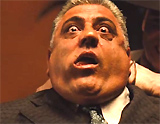 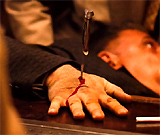 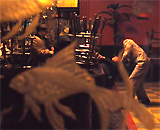
|
||||||||||||||||||||||

|
Next was the superbly-staged scene of a truce meeting in early 1946 between Michael Corleone (Al Pacino) and his family's sworn enemy Virgil Sollozzo (Al Lettieri) and his bodyguard, corrupt ('bought') police Captain McCluskey (Sterling Hayden). After picking Michael up, McCluskey apologized for the hospital incident as he frisked him for weapons: "I guess I'm getting too old for my job, too grouchy. Can't stand the aggravation. You know how it is." They first drove toward New Jersey - when Sollozzo's driver Lou suddenly took an abrupt, squealing U-turn on the George Washington Bridge. They arrived back in New York at LOUIS' Italian-American RESTAURANT in the Bronx - a quaint, neighborhood place with only four other diners. It was a perfect, out-of-the-way, set up location for assassinating both of them point-blank. During a meal of veal, Michael went to the restroom after being given permission by McCluskey: "You gotta go, you gotta go." He was relieved to find the gun planted for him (by Clemenza (Richard Castellano)) behind the old-fashioned toilet fixture. An unseen subway train passed loudly by - the noise paralleled the tremendous strain in Michael's head. After returning to the table, Sollozzo continued talking in Sicilian to him, but Michael was suffering too much mental anguish to listen - tension was raised as he sat and the sound of Sollozzo's words faded as the camera showed a closeup of Michael's face. He stood, quickly shot Sollozzo in the head, and then shot a stunned McCluskey once in the throat and once in the forehead. As instructed, he quickly walked to the door and dropped the gun, and was driven away by Tessio (Abe Vigoda) in a waiting car. |
 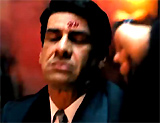 Death of Sollozzo 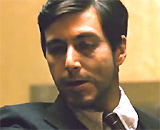 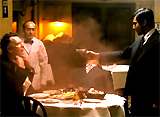  Death of Captain McCluskey |
||||||||||||||||||||||

|
The most violent scene in the film was the spectacular ambush and machine gun assassination at the tollbooths located at Point Lookout on the Jones Beach Causeway. Weak-willed Carlo Rizzi (Gianni Russo), the abusive husband of Sonny Corleone's (James Caan) sister Connie (Talia Shire), had betrayed Sonny and set him up for a "hit" by rival Mafia chief Emilio Barzini (Richard Conte). After the toll-taker in the causeway ducked below the toll-booth window, Sonny was ambushed and massacred by gangsters with machine guns hiding in the toll-booth, delivering a merciless fusillade of bullets. He tried to escape from his car by crawling out the passenger side door, but was caught in the middle of more intense gunfire. His body was propelled back against the car before he dropped to the pavement. Sonny's assassins unnecessarily kicked his corpse after he'd been shot and killed. It was a grisly, bullet-riddled death (with 147 explosive squibs). |
    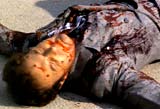
|
||||||||||||||||||||||

|
In a vivid and classic death scene among tomato plants in a garden in 1954, Don Corleone (Marlon Brando) played with son Michael's three year old son Anthony, his grandchild. He taught Anthony how to use a spray can, and then scared him by putting a sliced piece of orange peel in his mouth and pretending to be a grotesque boogey monster. He comforted his frightened grandson in his arms. While running with the boy in the garden, the Don suffered a fatal heart attack, stumbled, and fell dead. [Note: It has been widely speculated that the appearance of oranges in the film - in many instances - indicated death or the threat of violence for the character interacting with the orange.] |
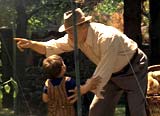  
|
||||||||||||||||||||||

|
In the film's conclusion - a coordinated campaign of revenge and massacre was orchestrated during the christening of Michael's nephew and godchild (Carlo (Gianni Russo) and Connie's new son), where Michael was at the church altar, listening to holy recitations of the priest during the baptism and renouncing Satan. To consolidate his power as the new godfather. he was targeting each of the Dons of the other leading Families in New York, plus a mobster in Las Vegas.
In the first of the so-called "Baptism Murders", Clemenza (Richard Castellano) killed Don Victor Stracci (Don Costello) and an associate as they emerged from an elevator in the St. Regis Hotel. Another rival mobster victim was Moe Green (Alex Rocco), seen in a massage and sun lamp room in Las Vegas, where he was shot through the eye (through his black-rimmed glasses) by an unknown assailant - blood dripped down his face from behind the shattered lens. The next to die was Don Carmine Cuneo (Rudy Bond) trapped in a set of revolving doors in the front of the St. Regis Hotel, shot by Willy Cicci (Joe Spinell). Rocco Lampone (Tom Rosqui) and another man machine-gunned Philip Tattaglia (Victor Rendina) and a 'whore' naked in bed. Posing as a uniformed New York cop, Al Neri (Richard Bright) killed Barzini's bodyguard (with two shots), Barzini's limo chauffeur (with another shot), and Barzini (Richard Conte) himself (with three shots in the back as he fled up a flight of courthouse stairs). Clemenza was also ordered to murder Carlo for betraying Sonny Corleone to the Barzini family (the tollbooth murder). Carlo was killed in a brutal and painful manner - strangled from behind with a piano wire while inside a car bound for the airport. Carlo valiantly kicked a hole through the car windshield as he tried to break free while being choked to death. |
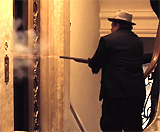 Elevator Murder of Don Stracci  Death of Moe Green 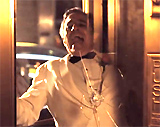 Death of Don Cuneo 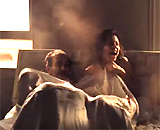 Death of Tattaglia 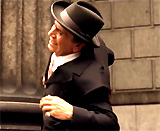 Death of Barzini  Strangulation of Carlo |
||||||||||||||||||||||
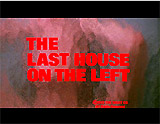
|
The Last House on the Left (1972) This taboo-breaking and often revolting 'snuff'-type film (originally titled "Night of Vengeance") featured the long murderous ordeal of two teenaged girls:
The teens were searching for pot when kidnapped by a sadistic group of escaped convicts led by Krug Stillo (David Hess). Phyllis' dark blue blouse was opened to expose her breasts, and then Krug punched her in the stomach and raped her. In one disturbing scene once they were taken to a woodsy area, blue-wearing Phyllis was forced to urinate with her clothes on ("Piss (in) your pants...Do it!"). The camera panned down, showing her wettened blue-jeans. Then, the two teens were stripped naked and forced to have oral sex with each other ("Make them make it with each other!"). The girls went ahead, rationalizing: "lt's just you and me here. Nobody else. Just you and me, okay?" Phyllis made a run for it, but was cornered, stabbed in the back by Fred "Weasel" Podowski (Fred Lincoln) and then dis-emboweled (after repeated stabbings) and butchered, after which psychopathic, sadistic gang member Sadie (Jeramie Rain) reached in and pulled out her gooey intestines to examine them. Phyllis' left hand and half of her forearm were amputated (off-screen).
Meanwhile, red-wearing Mari was surrounded, and Krug removed her pants ("You're gonna get yours"). She had Krug's name bloodily carved into her upper chest and was then brutally raped (as he drooled onto her face). She vomited as she walked dazedly into a nearby pond to half-submerge and cleanse herself. Krug shot and killed her there, and she floated on the water's surface.
This ugly scene was intercut with views of 'surprise party' preparations for Mari by her parents John and Estelle Collingwood (Gaylord St. James and Cynthia Carr). Ironically, in a later scene, the escaped convicts took refuge in the home of the upscale small-town parents, the hospitable Collingwoods - where there was animalistic payback revenge/slaughter of the gang.
In grotesque sequences of ultra-violent revenge, the father semi-electrocuted Krug, chipped out his teeth out with a chisel (in a dream sequence) and pursued him with a chainsaw and killed him (off-screen, evidenced by blood splatter). Meanwhile outdoors, the mother cleverly enticed gang member "Weasel" to have sex (she had also convinced him to have his hands tied behind his back) - he told her: "Now you just unzip me, and that's all l'll need you for." At first, his penis ("little thing...poor little fellow") became caught in his zipper and he was unresponsive, but as she touched him more and more, he warned: "lf you don't watch it, l'm gonna come." She urged: "Please come then, sweetie." He asked: "Don't you want me to do you good and proper?" - she replied: "You can do both, can't you?" - he boasted: "Hell, yeah! I can come five or six times if you want me to." She sank down to crotch-height, and as he was climaxing, she viciously bit off and dismembered his penis. After returning home, she fought off Sadie with a knife, and then was able to slash her throat with the weapon in the pool. |
  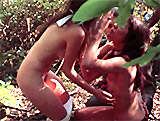  The Two Rape-Murder Victims  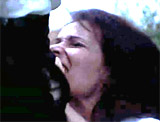 Weasel Fellated and Then Castrated  Sadie Slashed to Death with Knife in Pool |
||||||||||||||||||||||

|
Last Tango in Paris (1972, Fr./It.) (aka Ultimo Tango a Parigi) Alienated, middle-aged American businessman and widower Paul (Marlon Brando) was telling his young lover Jeanne (Maria Schneider), after they had broken up, that their previous secretive and mostly sexual affair was over - but that a new one was beginning. He wanted to resume their relationship:
He told her some details of his brutalized life, things that he had withheld from her in the past: "Yeah, listen. I'm 45. I'm a widower. I own a little hotel. It's kind of a dump, but not completely a flop house. Then I used to live on my luck and I got married, and my wife killed herself." Their original relationship had lost its anonymity, which she thought was preferable: "It's better not knowing anything." She wished to break off their relationship, but Paul didn't want to lose her and chased her back to her mother's Parisian apartment. He approached her: "How do you like your hero? Over-easy or sunny-side up? You ran through Africa and Asia and Indonesia. And now I've found you. And I love you. I wanna know your name." Suddenly a shot rang out after he asked to know her name. She spoke her name "Jeanne" at the same moment he was shot point-blank in the stomach. Paul staggered to the balcony (murmuring: "Our children. Our children. Our children...will remember"), where he removed his chewing gum from his mouth and stuck it under the railing. In the next view, he had collapsed and died in a fetal position. The camera tracked backwards to reveal the skyline, and Jeanne standing there with a revolver in her hand (her father's pistol from his military days). Dazed, Jeanne muttered the last lines of the film to herself (in French, translated below), rehearsing her lines that she would have to deliver to the police to explain his death (rationalizing and reassuring herself that it was self-defense when the stranger attempted to rape her):
|
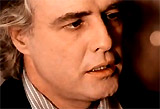 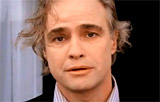 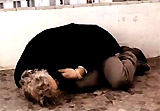   Paul Shot Point-Blank and Dying in Fetal Position 
|
||||||||||||||||||||||
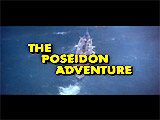
|
The Poseidon Adventure (1972) On the capsized SS Poseidon, overweight Jewish passenger Mrs. Belle Rosen (Oscar-nominated Shelley Winters) proposed rescuing Rev. Frank Scott (Gene Hackman) from drowning. As she dove in, she assured her husband Manny (Jack Albertson): "Do you think I'm planning to be careless?" She held her breath and swam a tremendous distance underwater to remove steel plate wreckage from atop Rev. Scott that saved his life. When they emerged in the flooded engine room, she gasped:
But then as she strenuously struggled to get out of the water, she suffered severe chest pains and fell backwards into the water. Rev. Scott dragged her to safety above water, as she admitted:
As she gave up hope of living, Rev. Scott begged her: "Hold on, Mrs. Rosen, just hold on." She wanted to die: "Enough is enough. Let me go. Please let me go!" She gave him a necklace symbol ("the sign for life") to give to her husband:
The stroke was fatal. Rev. Scott sobbed to God: "Oh, God. God, not this woman." Later, Manny also grieved over his wife's death. |
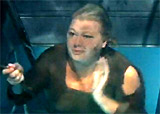 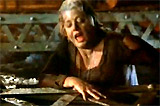 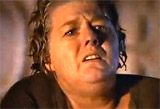 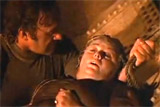   Death by Fatal Stroke (Not Drowning) |
||||||||||||||||||||||
(chronological by film title) Intro | 1915-1929 | 1930-1933 | 1934-1938 | 1939 | 1940-1942 | 1943-1945 | 1946-1947 | 1948-1949 1950-1952 | 1953-1955 | 1956-1957 | 1958-1959 1960-1961 | 1962-1963 | 1964-1966 | 1967-1968 | 1969-1970 1971 | 1972 | 1973 | 1974 | 1975 | 1976 | 1977-1978 | 1979 1980 | 1981 | 1982 | 1983 | 1984 | 1985 | 1986 | 1987 | 1987 | 1988 | 1989 1990 | 1991 | 1992 | 1993 | 1994 | 1994 | 1995 | 1995 | 1996 | 1997 | 1998 | 1998 | 1999 2000-2001 | 2002 | 2003 | 2004 | 2005 | 2006 | 2007 | 2008 | 2009 | 2010 | 2011 |